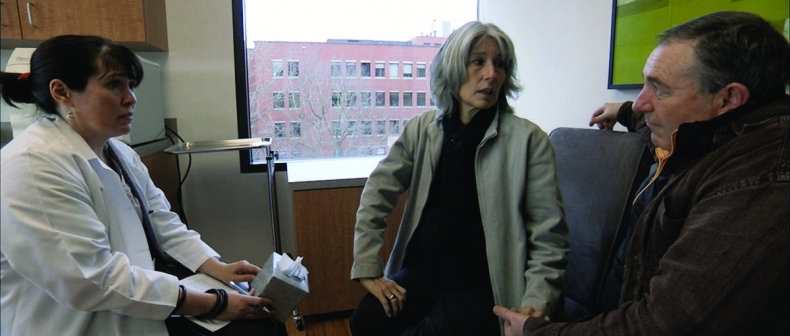
One of the most moving, memorable films of last year was Peter Richardson’s documentary How to Die in Oregon, which looks at the right-to-die debate from the perspective of several terminally ill people. Though made for HBO, I saw it as part of the Hot Docs film festival, and it was one of the most emotional moviegoing experiences I’ve ever had. We witness several death scenes, and the whole film is suffused with the sad, blunt awfulness of mortality faced head-on. Yet it’s suffused with grace, too, and the dignity of the people onscreen buoys us whenever we think we can’t bear to watch any longer. I’m sure many of my fellow audience members would’ve preferred to see it at home, where they could cry without self-consciousness. Fortunately, that’s now possible, the film having been released on DVD this week.
How to Die in Oregon begins with an ending. An elderly man, Roger Sagner, sits on a cot in his own home, surrounded by family. A woman fills a glass with a milky liquid, then, before handing it to him, asks two highly formal questions: “Do you know you have the right to change your mind?” and “What will this do to you?” Without hesitation, Sagner responds: “My mind’s not changing” and “It will kill me and make me happy.” With that, he swallows the stuff, makes a joke about how terrible it tastes, then stands and addresses the camera: “I thank the wisdom of the voters of the state of Oregon for allowing me the honour of doing myself in of my own volition.” The footage, it turns out, wasn’t shot for the film we’re watching. It was shot years ago by Sagner’s family, as advocacy for the so-called “dying-with-dignity” movement.
Oregon voted to legalize physician-assisted suicide in 1994 (it was the first of three states to do so; Canada hasn’t followed suit) and though Richardson is clearly championing those laws, his film isn’t a polemic. After that opening sequence, which establishes the still-controversial nature of the issue, Richardson spends the bulk of the film calmly documenting how the system works for individuals in need of it. We meet several subjects, but his chief subject is Cody Curtis, a 54-year-old wife and mother who barely survived a battle with liver cancer only to see it return full force. Given a prognosis of six months, she decides she’d prefer to die quickly and on her own terms rather than go through the pain again. She also wants to spare her family, and while her husband and daughter support her, her adult son feels she’s giving up too easily.
Curtis proves an ideal subject: articulate, educated, robust, and with a head of beautiful grey hair stopping just above the neckline. One look at this elegant, proud woman and we understand immediately what it would mean for her to lose control of her body and her faculties. “I understand there’s a kind of dignity in suffering,” she says at one point, “but there’s a certain grace in accepting the inevitable.” After getting the required approvals, she and her family set a date for her own demise, but her story becomes complicated when the expected pain never materializes. It will sooner or later, but in the meantime, Curtis finds herself in a sort of dazed limbo, each new day a disorienting yet welcome surprise.
A small contingent of the media, most notably The Washington Post, have criticized the film for being “biased” toward the death-with-dignity movement, which is such a ridiculously unfeeling response I barely know where to begin. If Richardson can be said to be “making a case” for right-to-die laws at all, he’s making the case passively, simply by showing us the laws in action. He’s not manipulating us and he’s not saying there aren’t other sides to the issue. He’s just showing us how the laws can benefit people. I could maybe understand the bias claim if Richardson had tried to amp up the already emotional material, but he approaches it clear-eyed and evenly; he never pushes us to “feel,” and as a result we feel for the people onscreen all the more deeply.
Though How to Die in Oregon is photographed quite handsomely, its aesthetic virtues are more journalistic than cinematic. Yet it culminates in a shot so transcendently beautiful, so inexpressibly lovely and sad, that no amount of “art” could improve it. Richardson holds the shot for some time before letting it dissolve, at which point you may almost feel yourself dissolving with it. The moment is, in visual terms, akin to the final, acquiescent lines of Joyce’s “The Dead.” But it isn’t cold snowflakes that come tapping against the window pane here — it’s the warm last rays of the sun.
Due to the gravity of the subject matter, films about the Holocaust always face good odds of acclaim, but is history really being served by yet another uninspired, “worthy” effort? Polish director Agnieszka Holland’s In Darkness tells the true story of a Lvov man named Leopold Socha (Robert Wieckiewicz) who kept a group of Jews hidden in the city sewers during the last year of the war, and while it contains some boilerplate suspense, it suffers badly from a lack of interesting characters. We’re introduced to the various Jews all at once, and they’re given, at best, one character trait apiece (most get less than that), which isn’t enough to sustain us through a nearly two-and-a-half-hour film. Leopold’s slow transformation from saviour-for-hire (he demands payment in return for his assistance) to actual saviour follows the usual, uninspired beats. Holland’s fellow countryman Andrzej Wajda tackled similar material in his 1957 film Kanal, which dramatized the retreat of the Polish Resistance through the sewers of Warsaw. But in his film, shot in black and white, the sewers are a stylized, highly expressive depiction of hell on earth. In Holland’s film, they’re just dank and drably realistic, which merely exacerbates the monotony. Do yourself a favour: rent Wajda’s film instead.
____
Scott Macdonald is Toronto Standard’s film critic. You can’t follow him on Twitter but you can close your eyes and wish him a happy Friday.
For more, follow us on Twitter at @torontostandard, and subscribe to our newsletter.














